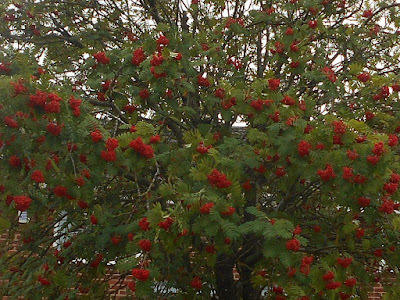 |
Rowans are having a good year. Trinity Close, Daventry.
18 August, 2018
|
Lords and Ladies, Arum maculatum, is currently also putting on a show, although their berries may not be quite as tempting.
 |
| Lords and Ladies at Daventry Golf Club. 16 August, 2018 |
These are joined by rose hips, holly berries, hawthorn fruits and, in our back garden, succulent honeysuckle berries.
 |
Lonicera periclymenum. A honeysuckle fruiting in our back garden.
Trinity Close, Daventry. 17 August, 2018
|
How strange it is, therefore, that many insects adopt similar scarlet coloration to do the exact opposite and warn birds that they are distasteful or even toxic.
Ladybirds are rejected by many birds and it is not surprising, as their bodies contain alkaloids, histamines and quinolenes, all of which are toxic to some degree. When alarmed many ladybird will exude an unpleasant fluid from joints in the legs. This behaviour is known as 'reflex bleeding'. Their bright red and black coloration is saying, in effect, 'Keep off!' Other ladybirds such as the brownish Larch Ladybirds, are not apparently toxic.
It comes as no surprise to learn that many harmless insects have adopted warning colours to fool would-be predators. This is known as Mullerian mimicry and I suspect that this Cinnamon Bug, Corizus hyoscyami, which I recently photographed in my front garden is rarely taken by birds. Many (most?) bugs have scent glands just behind the head and these, like ladybirds, exude an unpleasant fluid when the insect is alarmed, earning them the name of Stink Bugs, but the Cinnamon Bug is scentless.
Ladybirds are rejected by many birds and it is not surprising, as their bodies contain alkaloids, histamines and quinolenes, all of which are toxic to some degree. When alarmed many ladybird will exude an unpleasant fluid from joints in the legs. This behaviour is known as 'reflex bleeding'. Their bright red and black coloration is saying, in effect, 'Keep off!' Other ladybirds such as the brownish Larch Ladybirds, are not apparently toxic.
 |
| The 7-spot Ladybird exhibits reflex bleeding when alarmed. |
It comes as no surprise to learn that many harmless insects have adopted warning colours to fool would-be predators. This is known as Mullerian mimicry and I suspect that this Cinnamon Bug, Corizus hyoscyami, which I recently photographed in my front garden is rarely taken by birds. Many (most?) bugs have scent glands just behind the head and these, like ladybirds, exude an unpleasant fluid when the insect is alarmed, earning them the name of Stink Bugs, but the Cinnamon Bug is scentless.
 |
Corizus hyoscyami on lavender in our front garden. Trinity Close, Daventry.
17 August, 2018
|
It is an interesting bug, It was, until recently, more or less confined to sandy coastal areas in south-west England and South Wales, but has suddenly begun a remarkable expansion and I now see it frequently in the Daventry-Byfield area.
 |
Burnet moths contain cyanide-based compounds and are avoided
by birds.
|
Burnet moths...I could go on. Aposematism - the use of warning colours to avoid predation is a fascinating subject and is far too big a topic for a blog.
No comments:
Post a Comment